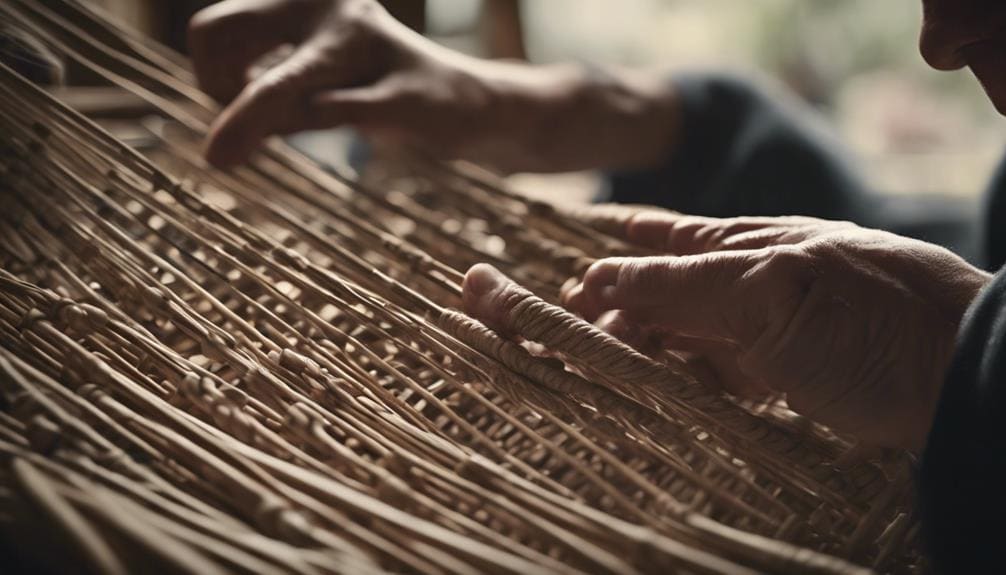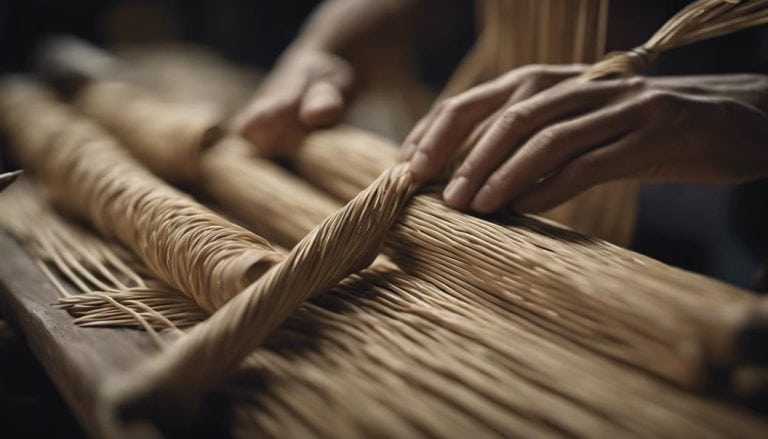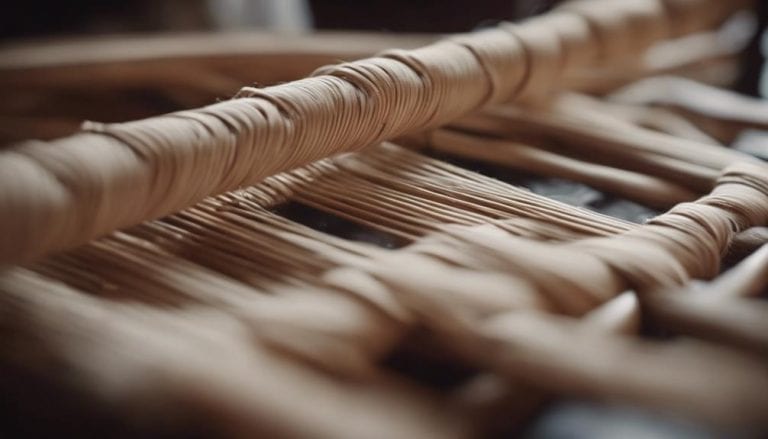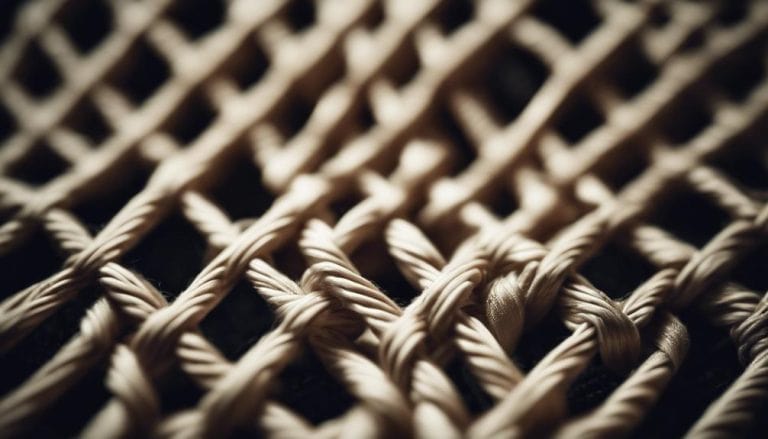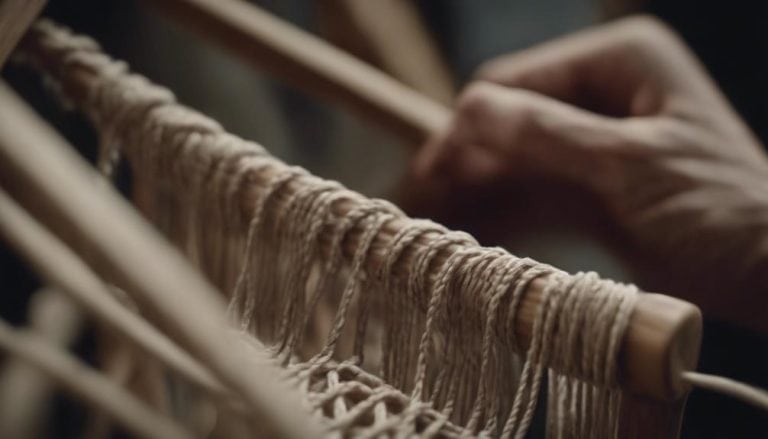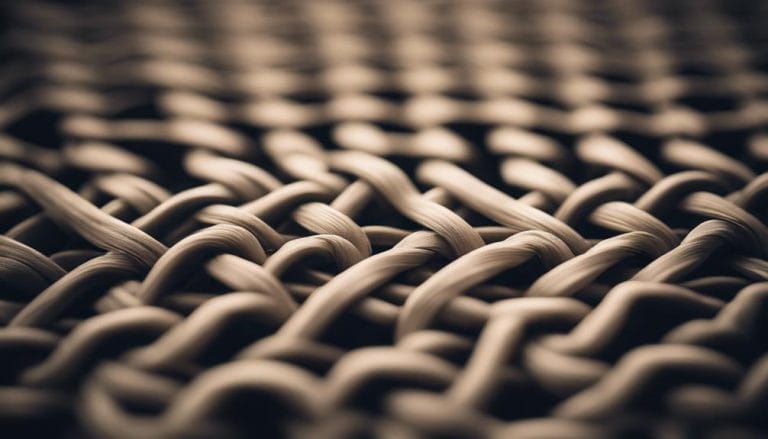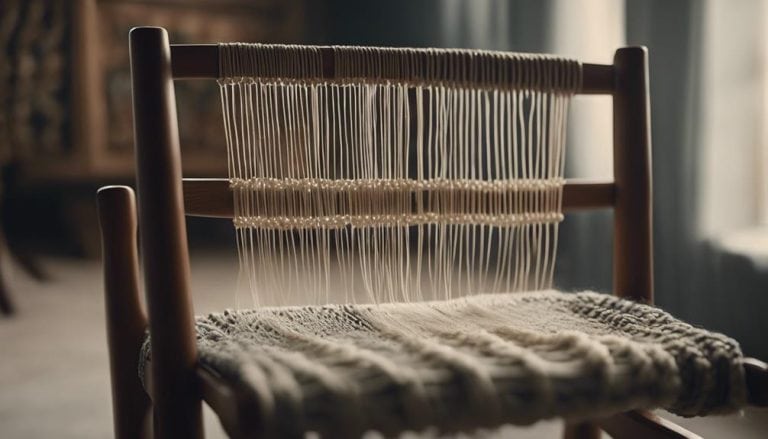Danish Cord Weaving on Rattan Cane
Weaving Danish Cord on rattan cane is like painting a canvas with intricate strokes, each thread adding depth to the design. The art of Danish Cord weaving intertwines tradition and craftsmanship to create timeless pieces.
Understanding the history and significance of this technique can shed light on its enduring appeal. From the materials needed to the finishing touches, mastering Danish Cord weaving opens the door to a world of creativity and artistry waiting to be explored.
In Danish cord weaving, a technique used on rattan cane, cords are woven in intricate patterns for furniture. This traditional method adds durability and a unique aesthetic to the furniture piece.
Key Takeaways
- Danish Cord weaving originated in the 1940s, emphasizing quality and beauty.
- Weaving techniques impact furniture design, inspiring modern craftsmen.
- Apply protective finishes to maintain flexibility and durability.
- Beginners should focus on mastering basic basketweave patterns and weaving orientation.
History of Danish Cord Weaving
Danish Cord Weaving, originating in the 1940s and propelled into popularity by designer Hans Wegner, has a rich history intertwined with craftsmanship and innovation. The origins of Danish cord weaving can be traced back to when Danish designers sought to marry practicality with beauty in furniture design.
Weaving tightly twisted, waxed kraft paper imported from Denmark into intricate patterns on open frames was a cultural influence that showcased the Danish commitment to quality and attention to detail. The labor-intensive process of Danish cord weaving not only resulted in durable chair seats but also reflected the Danish design philosophy of creating functional and aesthetically pleasing pieces.
The cultural influence of this weaving technique can be seen in the intricate basket weave designs that have become synonymous with Danish furniture. Through the skilled hands of craftsmen, Danish cord weaving elevated furniture design, setting a standard for quality and artistry that continues to be admired and emulated today.
Significance in Danish Design
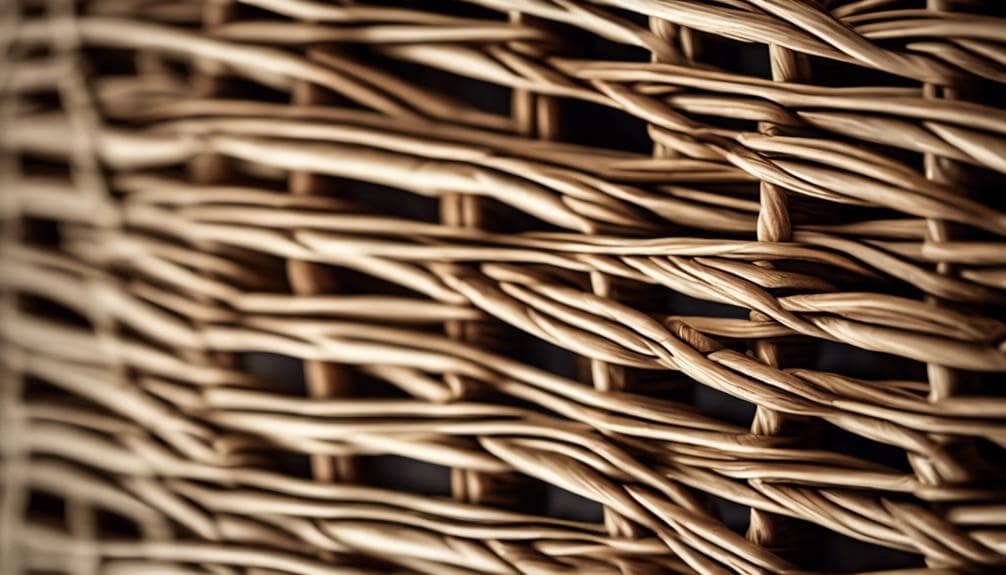
Incorporating rattan cane and Danish cord weaving in furniture design exemplifies a harmonious blend of traditional craftsmanship and contemporary aesthetics. This fusion goes beyond mere functionality, transforming pieces into works of art that speak to the heart of Danish design philosophy.
Here are four key points to delve deeper into the significance of Danish cord weaving on rattan cane:
- Modern applications: Rattan cane and Danish cord weaving inspire contemporary designers, offering a timeless appeal that transcends fleeting trends.
- Design inspiration: Cultural influences and artistic interpretations are pivotal in shaping Danish design, infusing each piece with a story that resonates with audiences worldwide.
- Craftsmanship legacy: Danish designers like Hans Wegner and Niels Otto Møller have left a lasting legacy by incorporating rattan cane and Danish cord weaving, showcasing the enduring beauty and versatility of these materials.
- Attention to detail: The intricate weaving techniques required highlight the meticulous craftsmanship and attention to detail synonymous with Danish furniture design, ensuring each piece is a true masterpiece.
Materials Needed for Weaving
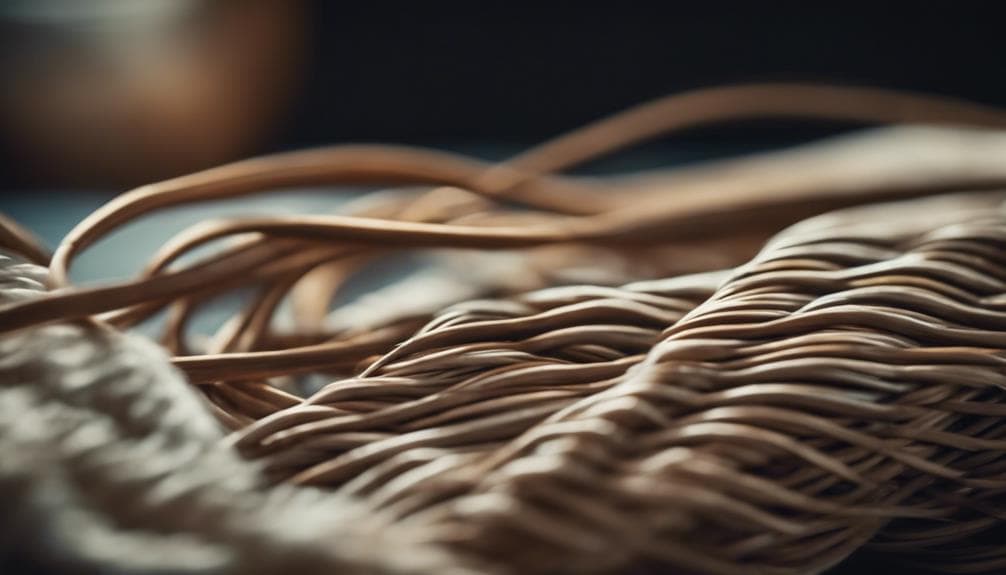
In exploring the materials required for weaving Danish cord on rattan cane, the focus shifts towards sourcing high-quality 3-ply Danish Cord material in specific shades like light tan, white, and black for authenticity and durability. Sourcing suppliers that provide these specialized materials is crucial to ensure the success of the weaving project.
Finding the right color options is essential to achieve the desired aesthetic appeal and match the traditional Danish design principles. When working with Danish cord weaving on rattan cane, one might encounter weaving challenges, particularly at the front-to-back weaves on the front rail, which is a common breaking point.
Understanding troubleshooting techniques can help navigate through these hurdles and maintain the integrity of the weave. It’s important to be prepared to tackle these issues effectively to produce a high-quality and long-lasting finished product.
Preparing the Rattan Cane Frame
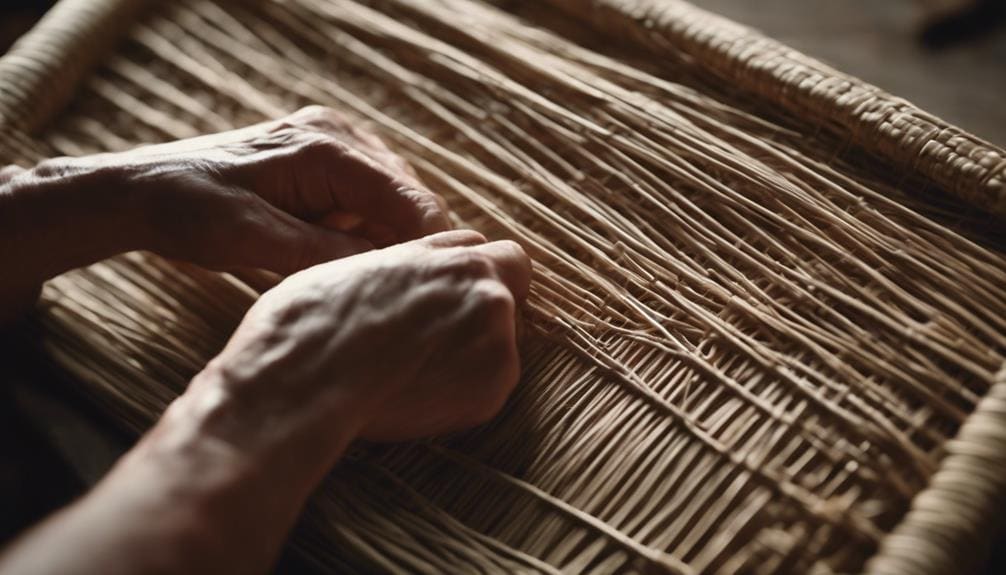
Preparing the rattan cane frame involves thorough cleaning and meticulous inspection to ensure a smooth and sturdy foundation for the Danish cord weaving process.
Here is a detailed guide to preparing the rattan cane frame:
- Cleaning: Clean the rattan cane frame with a damp cloth to remove any dust or debris that could affect the weaving process.
- Sanding techniques: Use sandpaper to smooth out any rough edges on the frame. This step is crucial to prevent splinters and ensure a clean finish for the Danish cord weaving.
- Frame inspection: Carefully examine the rattan cane frame for any signs of damage or weak spots. I addressed any issues before weaving, which is essential to avoid complications later.
- Securing the frame: Properly secure the rattan cane frame using hooks or nails to provide stability during weaving. A secure frame is key to achieving a well-executed Danish cord-weaving project.
Weaving Techniques and Patterns

Embarking on the intricate art of Danish cord weaving on rattan cane entails mastering various weaving techniques and patterns to create visually captivating and structurally sound furniture pieces. When exploring weaving techniques, it’s essential to experiment with patterns like the classic basket weave or the intricate double Danish cord design.
The weaving orientation also significantly impacts the final appearance of the piece, so careful attention to detail is crucial. To anchor the cords securely, inserting hooks around the seat perimeter is a common practice.
Continuous tightening of the weave throughout the process ensures a sturdy and professional finish. For those looking to elevate their work, incorporating unique color combinations and creative designs can add a personalized touch. Additionally, delving into advanced techniques and being prepared with troubleshooting tips will help navigate any challenges that may arise, ensuring a successful and visually stunning outcome.
Finishing Touches and Maintenance
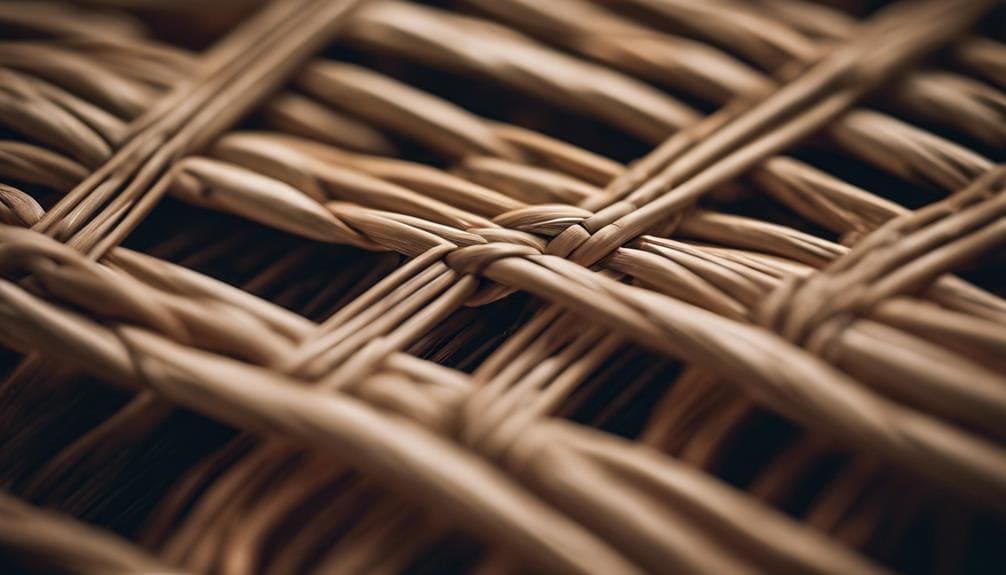
Enhancing the longevity and visual appeal of Danish cord weaving on rattan cane involves applying a protective finish of clear wax or oil. This not only protects the material but also accentuates its natural beauty.
Here are some essential tips for maintenance and preservation:
- Cleaning Tips: Regularly dust the Danish cord weaving with a soft, damp cloth to remove dirt or debris. Avoid using harsh chemicals that can harm the material.
- Protective Finishes: Apply a thin clear wax or oil coat to the rattan cane to maintain its flexibility and strength. This protective layer helps preserve the weaving and prevents it from drying out or becoming brittle.
- Longevity Benefits: Proper maintenance can significantly extend the lifespan of your Danish cord-weaving furniture, keeping it sturdy and visually appealing for years to come.
- Preservation Techniques: By following these cleaning and finishing practices, you can ensure that your Danish cord weaving on rattan cane remains in top condition, showcasing its intricate patterns and maintaining its structural integrity.
Tips for Beginners
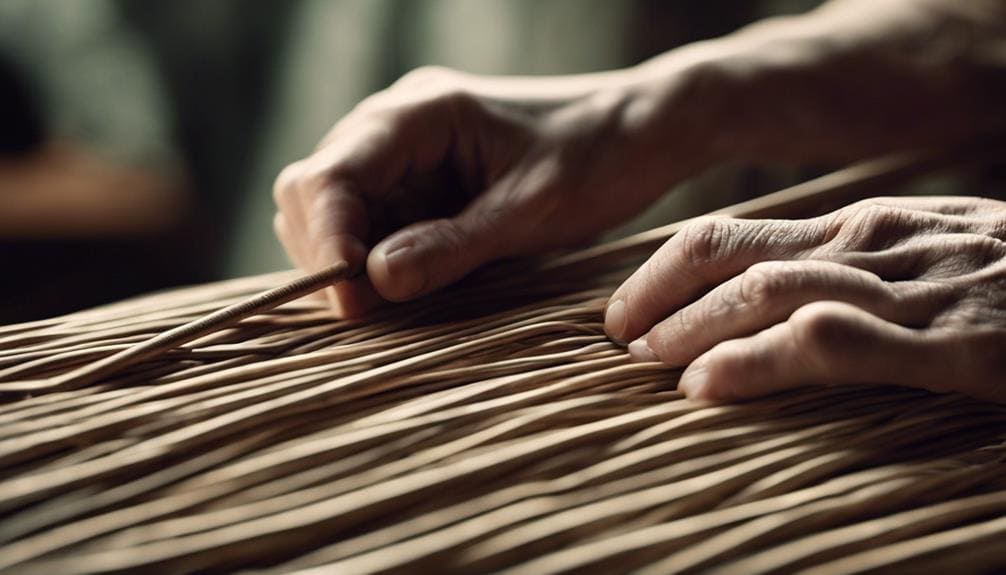
When starting with Danish cord weaving on rattan cane, understanding the basic basket weave patterns is essential for beginners. These patterns form the foundation of your weaving and help create the unique Danish cord style. As a beginner, focusing on mastering these basic techniques will set you up for success in more intricate designs down the line.
One common mistake beginners make is not paying attention to weaving orientation. The visual effects in your design heavily rely on the direction of your weave, so be mindful of this as you work through your project. Another common error is forgetting to tighten the weave continuously. Tightening the cord as you go ensures a durable and aesthetically pleasing result. Remember to regularly adjust the tension to keep your weave neat and uniform.
Frequently Asked Questions
What Are the Different Types of Danish Cord Weaving?
Regarding Danish cord weaving, various types showcase intricate techniques and patterns. The choice of materials impacts durability. Learning from tutorials can enhance design skills and maintenance knowledge for creating unique designs.
What’s the Difference Between Laced and Unlaced Danish Cord?
Choosing between laced and unlaced Danish cord involves considering weaving techniques and the desired aesthetic. Laced cord adds traditional charm with visible stitches, while unlaced offers a sleeker look. Pros and cons depend on style preferences and furniture design.
How Long Does Danish Cord Last?
I’ve observed that the longevity of the Danish cord depends on how well you maintain it. Regular cleaning and avoiding excessive strain can significantly extend its lifespan. This weaving can last for decades with proper care, adding timeless style to your space.
What Is the Nail Spacing for Danish Cord Weaving?
I place nails 1/2 to 1 inch apart for Danish cord weaving. This spacing ensures even cord tension and a secure weave. Consistent nail placement maintains structural integrity and enhances the overall aesthetic appeal of the weave.
Conclusion
As I sit back and admire the intricate patterns and timeless beauty of my newly woven Danish Cord seat, I can’t help but feel like I’ve captured a piece of history in my own home. The rhythmic weaving of the cord and the rattan cane’s sturdy frame all come together like a beautiful tapestry of memories and craftsmanship. Restoring Danish furniture is like breathing new life into a piece of art, preserving its legacy for generations.

